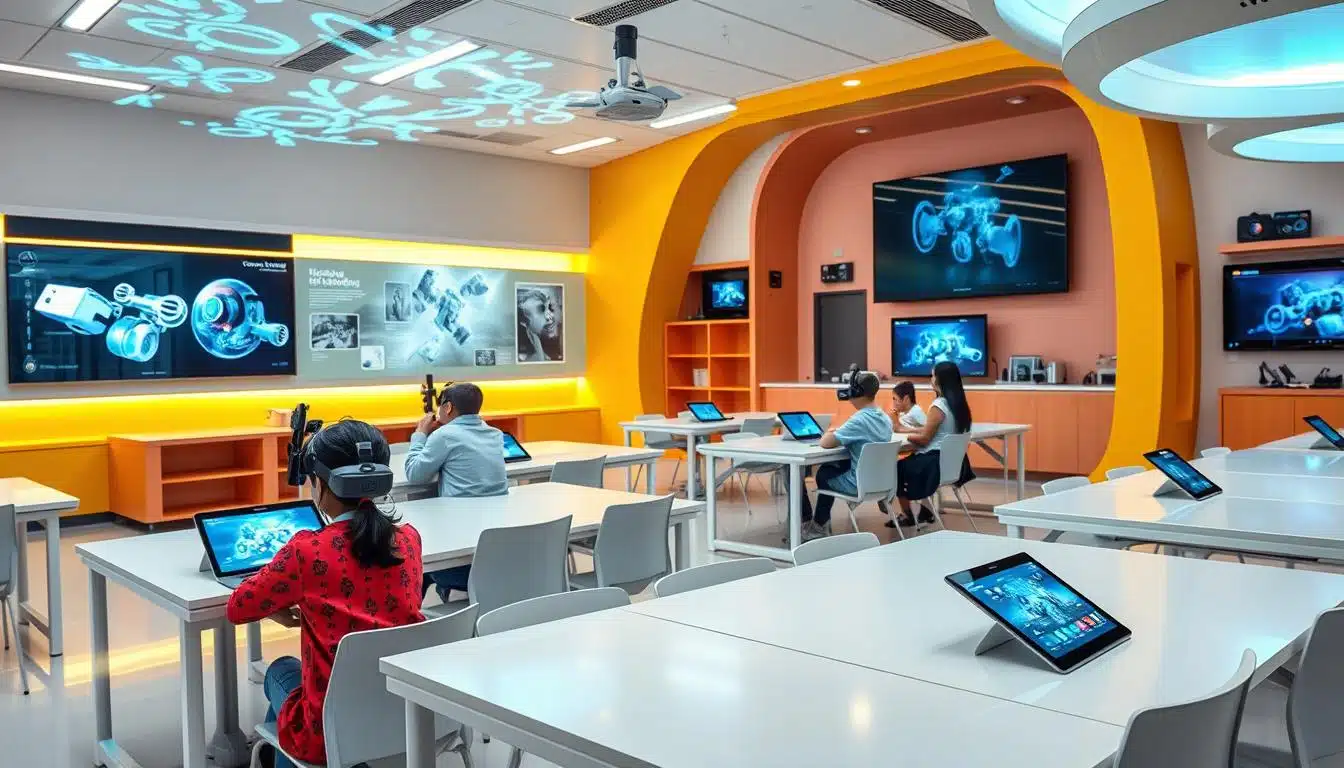Digital technology has changed how students learn and teachers teach. It includes tools like interactive whiteboards and online learning platforms. This article will look at how digital education is changing classrooms and its benefits for students and teachers.
We’ll talk about the growing use of online education technology and how edtech tools are being used in classrooms. We’ll also explore the impact of artificial intelligence (AI) on education. Suraasa’s AI-powered tools will be highlighted for improving teaching and learning.
Key Takeaways
- 75% of teachers use digital technology in the classroom to enhance teaching and learning.
- Online education technology has seen a 46% increase in usage by students in the past three years.
- 80% of students find digital learning more engaging compared to traditional methods.
- K12 publishers have reported a 60% increase in the adoption of digital textbooks over the last five years.
- Schools utilizing digital classroom technology have shown a 25% increase in student performance compared to those without such technology.
Digital Technology in the Classroom
Digital technology has changed education, turning classrooms into interactive learning spaces. It includes online tools and EdTech, reshaping education.
Online Education Technology
Online education technology lets students access content, do homework, and talk to teachers online. It offers flexible learning, meeting the needs of today’s students.
EdTech in the Classroom
EdTech uses digital tools to improve teaching and learning. It includes apps, games, and virtual reality. These tools make learning fun and engaging.
Digital Learning
Digital learning uses technology for learning, like online courses and interactive content. It allows for personalized learning, empowering students to learn at their own pace.
Digital classroom technology, like interactive whiteboards, helps with learning and teamwork. K12 publishers and content aggregators provide resources for digital learning.
“The integration of technology in education has the potential to transform the learning experience, fostering greater engagement, personalization, and collaboration among students.”
Digital technology in classrooms is key for preparing students for the future workforce.
AI Integration in Education
Artificial intelligence (AI) is changing how we learn and teach. An AI classroom uses AI to make learning better for everyone. It makes education more personal, adaptable, and fun.
What is an AI Classroom?
An AI classroom uses advanced AI tools to change education. It includes smart tutoring, automated grading, and learning platforms that fit each student. This way, every student gets the right help and support.
How AI in Classrooms Improves Learning Experiences
Using AI in the classroom makes learning better in many ways:
- Personalized Learning: AI helps tailor lessons to each student’s needs. This ensures everyone gets the right support.
- Enhanced Teacher Efficiency: AI handles tasks like grading and tracking, freeing teachers to focus on teaching and helping students.
- Diverse Learning Support: AI tools help students with different needs, making education fair for all.
- Interactive and Engaging Learning: AI makes learning fun with virtual simulations, games, and smart feedback, keeping students interested.
The use of artificial intelligence in education is growing fast. By 2030, it’s expected to grow by over 28% each year. This means AI will play a big role in shaping the future of learning and teaching.
“AI has the potential to revolutionize education by personalizing learning, automating administrative tasks, and creating more engaging and interactive classroom experiences.”
How AI Tools Are Transforming K-12 Education
AI is changing how teachers teach and students learn in K-12 schools. AI tools help make learning more personal and flexible for each student. They also make teaching easier by handling tasks like grading and giving feedback.
An AI Lesson Plan Generator lets teachers quickly make lesson plans that fit the curriculum. An AI Quiz Generator adjusts quizzes based on how well students do. Tools like the Rubrics Generator for grading make it easier to see how students are doing.
Teachers can use AI to focus more on teaching and less on paperwork. This makes learning more fun and interactive for students.
The School Teams AI Collaborative will start in Denver on October 16-18, 2024. It will bring together over 80 educators from 19 schools. They will explore how AI can help with lesson planning and reaching students.
A survey by Educators for Excellence showed that many teachers are using AI. But, only 14% feel sure about it. 58% want more training.
California’s Assembly Bill 2876 will make AI a part of math, science, and social studies. Marin educators are learning about AI and its ethics. The Gen AI Academy was started by a parent and student in Marin.
As AI in the classroom and AI tools for teachers improve, K-12 education is set for big changes. This will help teachers make learning more personal and fun for their students.
Suraasa’s AI-Powered Education Technology
Suraasa is a top education tech company. It offers AI tools to make teaching better and easier. These tools help teachers make learning materials, tests, and resources fast. This lets them focus more on helping students learn and succeed.
Sample Outputs from These Tools
The Lesson Plan Generator makes it easy to plan lessons that meet curriculum standards. The Rubrics Generator helps teachers set up clear criteria for assignments. The Quiz Generator creates fun quizzes to check how well students understand.
The Handout Generator makes informative and nice-looking handouts. The Narration Generator helps teachers write interesting stories for lessons. These tools make learning better and save teachers time.
- Suraasa’s AI tools adjust to each student’s learning style and speed, offering tailored help.
- These tools do tasks like grading and keeping track of attendance, making teachers more efficient.
- Suraasa’s AI solutions meet different learning needs, supporting inclusive education.
- The interactive learning activities from Suraasa’s AI tools make learning fun and engaging.
Suraasa’s AI education tech is changing how teachers teach. It creates learning environments that are personal and flexible. This helps students do well in school.
“Suraasa’s AI-powered tools have changed my teaching. The Lesson Plan Generator saves me a lot of time, and the Rubrics Generator makes sure my tests are fair and detailed.”
– Jane Doe, Middle School Teacher
Benefits and Drawbacks of Education Technology
Technology has changed education a lot. It brings new ways to learn and teach. But, it also has some downsides. Let’s look at the top 10 pros and cons of using technology in schools.
10 Pros of Technology in Education
- Interactive digital tools make learning fun and engaging.
- Online libraries and websites give students lots of information.
- Technology lets students learn at their own pace.
- It helps students work together, even if they’re far apart.
- Students get feedback right away, helping them learn faster.
- It prepares students for jobs that need tech skills.
- It helps different learning styles, making classes more inclusive.
- Virtual classrooms make learning possible even when schools are closed.
- It gives teachers insights to improve teaching and learning.
- It’s often cheaper than traditional classroom materials.
10 Cons of Technology in Education
- The internet can be a distraction for students.
- Too much tech can make students forget basic skills.
- Not all students have the same access to technology.
- Too much screen time can hurt social skills.
- Using digital tools can raise privacy concerns.
- Technical problems can interrupt learning.
- Teachers need training to use technology well.
- Too much tech can make students less active.
- Not all online resources are good or accurate.
- It can make cheating easier.
To make the most of technology in schools, we need a balanced approach. Schools should set clear rules and use both old and new teaching methods.
Striking a Balance with Education Technology
Technology is changing how we learn, but finding the right balance is key. Technology can definitely help improve learning, but teachers are still essential. They offer support, motivation, and personal guidance that tech can’t match.
Technology should help teachers, not take their place. By using technology wisely, schools can make learning better for everyone. This way, students and teachers both benefit from a great learning environment.
Schools need to set rules for using digital tools in class. Mixing old and new teaching methods helps students learn many skills. It’s also important to teach students how to use the internet wisely.
“Technology should complement, not replace, the role of teachers in the classroom. By striking a balance, we can create an educational environment that leverages the best of both worlds.”
By using technology smartly, schools can make learning better. Optimizing technology in education helps teachers and students alike. This balanced approach makes learning more effective and enjoyable for everyone.
Conclusion
The education world is changing fast, thanks to technology. It’s bringing new chances for learning and teaching. Interactive tools and AI are making a big difference in how we learn and teach.
Using technology wisely can make learning better and more fun. It’s important to find the right balance. This way, technology can help teachers, not replace them.
The online education market is growing fast, expected to hit $350 billion by 2025. Microlearning is also showing great results. It’s time for educators and leaders to keep up and use new tech wisely. This will help students learn better and get ready for the future.
FAQs
Q: What is educational technology?
A: Educational technology refers to the use of technology tools and resources to facilitate teaching and learning processes. It encompasses various applications including software, hardware, and digital content designed to enhance the educational experience.
Q: How can edtech improve the classroom experience?
A: Edtech can improve the classroom experience by providing interactive learning tools that engage students, enabling personalized learning experiences, and facilitating collaboration through technology. This results in a more dynamic and effective teaching and learning environment.
Q: What are some examples of educational technology?
A: Examples of educational technology include online learning platforms, instructional software, virtual reality tools, learning management systems, and various edtech tools that support collaboration and communication between students and teachers.
Q: What are the benefits of using technology in education?
A: The benefits of using technology in education include increased access to information, enhanced engagement through interactive content, the ability to personalize learning experiences, and improved communication between students and educators. Additionally, it fosters collaboration and prepares students for a technology-driven world.
Q: How does online education fit into educational technology?
A: Online education is a significant aspect of educational technology, offering flexible learning opportunities through virtual classrooms and online courses. It allows learners to access instructional content from anywhere, promoting distance education that accommodates various learning styles and schedules.
Q: What role do educators play in integrating technology use in the classroom?
A: Educators play a crucial role in integrating technology use in the classroom by selecting appropriate edtech tools, designing technology-enhanced lessons, and guiding students in using these technologies effectively. Their support is essential for maximizing the benefits of educational technology.
Q: How can technology help students succeed academically?
A: Technology can help students succeed academically by providing resources that cater to diverse learning needs, offering instant feedback through assessments, and allowing for collaborative projects that enhance critical thinking skills. It also enables access to a wealth of educational content and support systems.
Q: What is the impact of artificial intelligence on educational technology?
A: The impact of artificial intelligence (AI) on educational technology includes the ability to personalize learning experiences based on individual student data, automate administrative tasks for educators, and provide intelligent tutoring systems that adapt to students’ learning pace and style.
Q: What are the challenges of implementing technology in education?
A: Challenges of implementing technology in education include ensuring equitable access to technology, training educators to effectively integrate new tools, addressing privacy and security concerns, and maintaining student engagement in a technology-rich learning environment.










